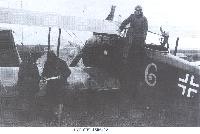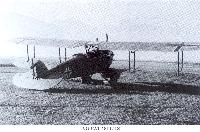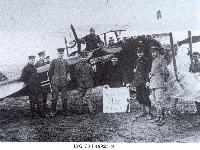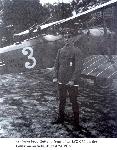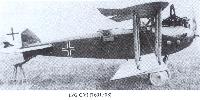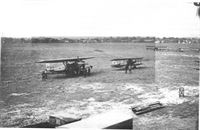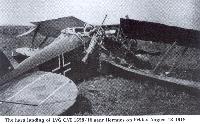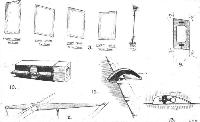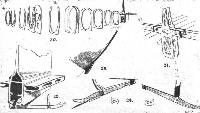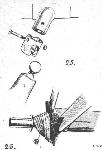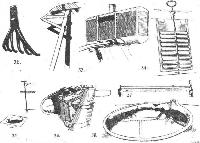
Описание
Страна: Германия
Год: 1918
Two-seat reconnaissance and artillery observation
Варианты
- LVG - C.V - 1917 - Германия
- LVG - C.VI - 1918 - Германия
- LVG - C.VIII - 1918 - Германия
- LVG - P.I / P.II - 1919 - Германия
- LVG - W.I / W.II - 1919 - Германия
- В.Кондратьев Самолеты первой мировой войны
- А.Александров, Г.Петров Крылатые пленники России
- O.Thetford, P.Gray German Aircraft of the First World War (Putnam)
- L.Andersson Soviet Aircraft and Aviation 1917-1941 (Putnam)
- E.Hauke, W.Schroeder, B.Totschinger Die Flugzeuge der k.u.k. Luftfahrtruppe und Seeflieger 1914-1918
- J.Herris LVG Aircraft of WWI. Vol.1: B-Types & C.I (A Centennial Perspective on Great War Airplanes 34)
- J.Herris LVG Aircraft of WWI. Vol.3: Types C.VI-C.XI & Fighters (A Centennial Perspective on Great War Airplanes 36)
- J.Forsgren Swedish Military Aircraft 1911-1926 (A Centennial Perspective on Great War Airplanes 68)
- M.Dusing German Aviation Industry in WWI. Volume 1 (A Centennial Perspective on Great War Airplanes 84)
- Z.Czirok German Aircraft in Hungarian Service (A Centennial Perspective on Great War Airplanes 92)
- P.Grosz, G.Haddow, P.Shiemer Austro-Hungarian Army Aircraft of World War One (Flying Machines)
- M.Kabatek, Fr.R.Kulczynski German Aircraft in Polish Service. Volume 1
- Журнал Flight
-
В.Кондратьев - Самолеты первой мировой войны
LVG C-VI ВВС Германии, 1918г.
-
J.Herris - LVG Aircraft of WWI. Volume 3: Types C.VI-C.XI & Fighters /Centennial Perspective/ (36)
LVG C.VI 1562/18 of Uffz. Friedemayer and Lt. Kuchenthal, unit unknown.
-
J.Herris - LVG Aircraft of WWI. Volume 3: Types C.VI-C.XI & Fighters /Centennial Perspective/ (36)
LVG C.VI 1563/18, unit unknown. Camouflage appears factory-applied as stencils can be seen over both colors.
-
J.Herris - LVG Aircraft of WWI. Volume 3: Types C.VI-C.XI & Fighters /Centennial Perspective/ (36)
LVG C.VI 1589/18 of Fl.Abt(A) 286b in the Summer/Fall of 1918. Several of the aircraft bore whimsical markings such as this bird head squeezing out of a beer tankard.
-
J.Herris - LVG Aircraft of WWI. Volume 3: Types C.VI-C.XI & Fighters /Centennial Perspective/ (36)
LVG C.VI 3976/18, unit unknown, Summer/Fall 1918.
-
J.Herris - Development of German Warplanes in WWI /Centennial Perspective/ (1)
LVG C.VI 3976/18 displays a modest black and white fuselage stripe over the standard factory finish.
-
J.Herris - LVG Aircraft of WWI. Volume 3: Types C.VI-C.XI & Fighters /Centennial Perspective/ (36)
LVG C.VI 4806/18, unit unknown, Summer/Fall 1918. Note the observer's Lewis gun and the vertical exhaust.
-
J.Herris - LVG Aircraft of WWI. Volume 3: Types C.VI-C.XI & Fighters /Centennial Perspective/ (36)
LVG C.VI 4891/18, unit unknown, Summer/Fall 1918. Fuselage cross is ahead of usual position, and the serial number has been re-applied forward of it sans "LVG C.VI" and year.
-
R.Bennett - Last Gathering of Eagles 1918-1920 /Aeronaut/
LVG C.VI 7766/18, #1, FA 423 / Artillerie-Fliegerstaffel 116, Weimar, 1919.
-
R.Bennett - Last Gathering of Eagles 1918-1920 /Aeronaut/
LVG C.VI 12017/18, FA 433, Baltic Landeswehr, Kurland, 1919.
-
J.Herris - LVG Aircraft of WWI. Volume 3: Types C.VI-C.XI & Fighters /Centennial Perspective/ (36)
LVG C.VI 'H', unit unknown.
-
J.Herris - LVG Aircraft of WWI. Volume 3: Types C.VI-C.XI & Fighters /Centennial Perspective/ (36)
LVG C.VI '2', unit unknown.
-
J.Herris - LVG Aircraft of WWI. Volume 3: Types C.VI-C.XI & Fighters /Centennial Perspective/ (36)
LVG C.VI with checkerboard marking, unit unknown, Summer/Fall 1918.
-
J.Herris - LVG Aircraft of WWI. Volume 3: Types C.VI-C.XI & Fighters /Centennial Perspective/ (36)
LVG C.VI of Flieger Abteilung 19. The three-pointed 'Mercedes' star was the unit insignia.
-
J.Herris - LVG Aircraft of WWI. Volume 3: Types C.VI-C.XI & Fighters /Centennial Perspective/ (36)
LVG C.VI of Flieger Abteilung (A) 278s flown by Vzfw. Joseph Gawlik and Lt. Heckenleitner, downed by Adj. Raymond Vanier of Spa 57 on 19 July 1918.
-
R.Bennett - Last Gathering of Eagles 1918-1920 /Aeronaut/
LVG C.VI 'M', Kampfgeschwader Sachsenberg, November 1919.
-
Z.Czirok - German Aircraft in Hungarian Service /Centennial Perspective/ (92)
Captured German LVG C.VI of one of the reconnaissance squadrons belonged to the Mackensen army with unique personal markings on the fuselage
-
J.Herris - LVG Aircraft of WWI. Volume 3: Types C.VI-C.XI & Fighters /Centennial Perspective/ (36)
LVG C.VI turned over to the US Air Service postwar. Romoratin Aerodrome.
-
Z.Czirok - German Aircraft in Hungarian Service /Centennial Perspective/ (92)
LVG C.VI 4869/18 captured in Hungary in the winter of 1918/1919 and assembled at Rakos airfield in February 1919. The Czechoslovakians recaptured the aircraft and it served at 7. polni letecka setnina in May 1919
-
J.Herris - LVG Aircraft of WWI. Volume 3: Types C.VI-C.XI & Fighters /Centennial Perspective/ (36)
LVG C.VI 48.69 of the postwar Czech Air Service.
-
Z.Czirok - German Aircraft in Hungarian Service /Centennial Perspective/ (92)
LVG C.VI 7618/18 in Romanian colors after seizing in Hungary in 1919.
-
J.Herris - LVG Aircraft of WWI. Volume 3: Types C.VI-C.XI & Fighters /Centennial Perspective/ (36)
LVG C.VI 1505/18, 7st Eskadra Lotnicza, Lwow Aerodrome, 1919
-
M.Kabatek, Fr.R.Kulczynski - German Aircraft in Polish Service. Volume 1 /Aeronaut/
LVG C.VI 1505/18 of 7. Eskadra Lotnicza, flown by ppor. pil. Mieczyslaw Garsztka and por. obs. Kazimierz Swoszowski, Lviv, May 1919
-
M.Kabatek, Fr.R.Kulczynski - German Aircraft in Polish Service. Volume 1 /Aeronaut/
LVG C.VI 1574/18 of III Eskadra Wielkopolska, flown by ppor. pil. Jozef Manczak and sierz. obs. Jozef Klicze, Zhodzina, November 1919
-
M.Kabatek, Fr.R.Kulczynski - German Aircraft in Polish Service. Volume 1 /Aeronaut/
LVG C.VI 1599/18 of 3. Eskadra Lotnicza, flown by ppor. pil. Tadeusz Prauss and sierz. Karol Debski, Lublin, April 1919
-
M.Kabatek, Fr.R.Kulczynski - German Aircraft in Polish Service. Volume 1 /Aeronaut/
LVG C.VI (w/n 5098) of 12. Eskadra Wywiadowcza, flown by plut. pil. Jozefat Skrzypek and ppor. obs. Jerzy Roszkowski, Markowszczyzna, September 1920
-
M.Kabatek, Fr.R.Kulczynski - German Aircraft in Polish Service. Volume 1 /Aeronaut/
LVG C.VI 1505/18 of Oficerska Szkola Obserwatorow Lotniczych, flown by sierz. pil. Jozef Zuromski and por. obs. Chmielewski, Torun, May 1921
-
M.Kabatek, Fr.R.Kulczynski - German Aircraft in Polish Service. Volume 1 /Aeronaut/
LVG C.VI (Polish serial 550/18) of Oficerska Szkola Obserwatorow Lotniczych, Torun, 1921.
-
R.Bennett - Last Gathering of Eagles 1918-1920 /Aeronaut/
LVG C.VI 9092/18, Lithuanian Aviation Company, Aleksotas, 1919
-
J.Herris - LVG Aircraft of WWI. Volume 3: Types C.VI-C.XI & Fighters /Centennial Perspective/ (36)
LVG C.VI, Deutsche Luft-Reederei #30 postwar.
-
J.Herris - LVG Aircraft of WWI. Volume 3: Types C.VI-C.XI & Fighters /Centennial Perspective/ (36)
LVG C.VI D 148 of the Deutsche Luft Reederei (later Lufthansa). This aircraft was flown by Lothar Freiherr von Richthofen when he flew German-American actress Fern Andra on a flight from Berlin-Hamburg when the fatal July 4, 1922 crash ocurred.
-
J.Herris - LVG Aircraft of WWI. Volume 3: Types C.VI-C.XI & Fighters /Centennial Perspective/ (36)
The Shuttleworth's C.VI 7198/18 in a hangar. This aircraft has been retired from flying and is now displayed in the RAF Museum.
-
M.Dusing - German Aviation Industry in WWI. Volume 2 /Centennial Perspective/ (85)
Excellent restored Wolff propeller on a LVG C.VI replica. Engine: Benz Bz.IV.
-
J.Herris - LVG Aircraft of WWI. Volume 3: Types C.VI-C.XI & Fighters /Centennial Perspective/ (36)
View of the LVG C.VI in the Belgian Army Museum in Brussels in its original camouflage colors. The stained wood fuselage and camouflage fabric applied to the wings with light rib tapes come through clearly. The wheels are wood to replace the missing originals.
-
J.Herris - LVG Aircraft of WWI. Volume 3: Types C.VI-C.XI & Fighters /Centennial Perspective/ (36)
Views of the LVG C.VI in the Belgian Army Museum in Brussels in its original camouflage colors. The stained wood fuselage and camouflage fabric applied to the wings with light rib tapes come through clearly. The wheels are wood to replace the missing originals.
-
J.Herris - LVG Aircraft of WWI. Volume 3: Types C.VI-C.XI & Fighters /Centennial Perspective/ (36)
LVG C.VI Details in Color
-
J.Herris - LVG Aircraft of WWI. Volume 3: Types C.VI-C.XI & Fighters /Centennial Perspective/ (36)
LVG C.VI Details in Color
-
J.Herris - LVG Aircraft of WWI. Volume 3: Types C.VI-C.XI & Fighters /Centennial Perspective/ (36)
LVG C.VI Details in Color
-
J.Herris - LVG Aircraft of WWI. Volume 3: Types C.VI-C.XI & Fighters /Centennial Perspective/ (36)
The LVG C.VI was a more compact design derived from the LVG C.V and powered by a 220 hp Benz Bz.IVa. It was the last LVG combat type to go into production. Photographed during type-testing at Adlershof in February 1918, the obsolete ear radiators were fitted solely to expedite flight tests. (Peter M. Grosz Collection/SDTB)
-
J.Herris - LVG Aircraft of WWI. Volume 3: Types C.VI-C.XI & Fighters /Centennial Perspective/ (36)
Another view of prototype LVG C.VI 14400/17 during type-testing at Adlershof in February 1918. Teves & Braun developed an airfoil radiator for production C.VI aircraft. Elimination of the spinner used on the C.V and its replacement by a rounded nose gave the C.VI a less elegant, more purposeful appearance. (Peter M. Grosz Collection/SDTB)
-
J.Herris - LVG Aircraft of WWI. Volume 3: Types C.VI-C.XI & Fighters /Centennial Perspective/ (36)
LVG C.VI 1562/18 (works number 4012) wears an unusual camouflage scheme. (Peter M. Grosz Collection/SDTB)
-
J.Herris - LVG Aircraft of WWI. Volume 3: Types C.VI-C.XI & Fighters /Centennial Perspective/ (36)
Above: LVG C.VI 1562/18 with crew Uffz. Friedemayer and Lt. Kuchenthal. The original fuselage insignia has been reduced in size and the airfoil radiator in the center section is clearly visible.
Below: Close up of the camouflage applied to LVG C.VI 1562/18. -
J.Herris - LVG Aircraft of WWI. Volume 3: Types C.VI-C.XI & Fighters /Centennial Perspective/ (36)
Detail of the wing camouflage of LVG C.VI 1562/18.
-
J.Herris - LVG Aircraft of WWI. Volume 3: Types C.VI-C.XI & Fighters /Centennial Perspective/ (36)
Close up of the camouflage applied to LVG C.VI 1562/18.
-
J.Herris - LVG Aircraft of WWI. Volume 3: Types C.VI-C.XI & Fighters /Centennial Perspective/ (36)
Close up of the camouflage applied to LVG C.VI work number 4012. This is the fin from LVG C.VI 1562/18.
-
J.Herris - LVG Aircraft of WWI. Volume 3: Types C.VI-C.XI & Fighters /Centennial Perspective/ (36)
Another photo of LVG C.VI. 1562/18 (works number 4012) of Uffz. Friedemeyer (pilot) and Lt. Kuchenthal, with the bizarre camouflage scheme on the fuselage and both sides of the wings. The visitors in the strange uniforms are Swedish.
-
J.Herris - LVG Aircraft of WWI. Volume 3: Types C.VI-C.XI & Fighters /Centennial Perspective/ (36)
LVG C.VI 1563/18 (work number 4013) illustrates the LVG-developed integral machine gun ring which produced less drag than the previous LVG gun ring copied from the Scarff-ring. This C.VI has the fuselage camouflaged in two hazy colors - this is seen on other early production C.VI aircraft and it looks remarkably like the camouflage on the C.VIII prototype. (Peter M. Grosz Collection/SDTB)
-
J.Herris - LVG Aircraft of WWI. Volume 3: Types C.VI-C.XI & Fighters /Centennial Perspective/ (36)
The observer has a rack of flares and the crew of LVG C.VI 1669/18 is ready for their next mission. (Reinhard Zankl)
-
J.Herris - LVG Aircraft of WWI. Volume 3: Types C.VI-C.XI & Fighters /Centennial Perspective/ (36)
The observer in C.VI 1674/18 is Hptm. Eduard Wimmer, commander of Bavarian Fl. Abt. 48 (FA 48b). He is actually taking on two cages with carrier pigeons (Brieftauben). (Reinhard Zankl)
-
J.Herris - LVG Aircraft of WWI. Volume 3: Types C.VI-C.XI & Fighters /Centennial Perspective/ (36)
Last-minute instructions are given to the crew of LVG C.VI 1728/18 before its mission. The canister above the radiator condenser indicates a cooling system problem eliminated on later aircraft. The observer has a flare gun and a good supply of flares.(Peter M. Grosz Collection/SDTB)
-
J.Herris - LVG Aircraft of WWI. Volume 3: Types C.VI-C.XI & Fighters /Centennial Perspective/ (36)
LVG C.VI 3976/18 carries a two-color fuselage band and late 1918 insignia. The unit is unknown. Visible changes from the LVG C.V to C.VI included deletion of the spinner and replacement by a streamlined nose, replacement of the leading edge radiator with centrally-mounted airfoil radiator, elimination of horn-balanced ailerons, an angular cut-out in the upper wing trailing edge, modified cabane structure, and a generally chunkier appearance. The observer's gun ring was also lower and less prominent.
-
J.Herris - LVG Aircraft of WWI. Volume 3: Types C.VI-C.XI & Fighters /Centennial Perspective/ (36)
LVG C.VI 4806/18 at the front with tactical number '6' applied. The observer had a captured Lewis machine gun, and recognition streamers are attached to the lower wing. Production LVG C.VI aircraft had an airfoil radiator in the upper wing center section instead of a leading edge radiator like the C.V. (Peter M. Grosz Collection/SDTB)
-
Сайт - Pilots-and-planes /WWW/
LVG C.VI 4806/18
-
J.Herris - LVG Aircraft of WWI. Volume 3: Types C.VI-C.XI & Fighters /Centennial Perspective/ (36)
Colorfully-marked LVG C.VI 4891/18 of an unidentified unit. The box mounted on the side of the observer's cockpit was a unit modification to hold hand grenades, either the Wurfgranate 15 (throwing grenade) or Iflmaus (infantry mouse, also known as the Fliegermaus), or flares. (Peter M. Grosz Collection/SDTB)
-
J.Herris - LVG Aircraft of WWI. Volume 3: Types C.VI-C.XI & Fighters /Centennial Perspective/ (36)
Light-colored LVG C.VI 7154/18 if photographed at Breslau in 1919; a Halberstadt C.V heads the lineup at left.
Другие самолёты на фотографии: Halberstadt C.V/C.IX - Германия - 1918
-
J.Herris - LVG Aircraft of WWI. Volume 3: Types C.VI-C.XI & Fighters /Centennial Perspective/ (36)
Preserved LVG C.VI 7198/18 at Farnborough is the same aircraft later owned and flown by the Shuttleworth Trust. In the early 1960's it had this weird and inaccurate camouflage scheme, but by 1969 was restored to a very accurate state.
-
J.Herris - LVG Aircraft of WWI. Volume 3: Types C.VI-C.XI & Fighters /Centennial Perspective/ (36)
LVG C.VI 7640/18 from the fifth production batch photographed on the factory airfield.
-
Z.Czirok - German Aircraft in Hungarian Service /Centennial Perspective/ (92)
LVG C.VI 7715/18 landed at Cheb on 22nd June 1919 after their flyers lost their way. The aircraft returned to Germany ten months later. (Petr Lukes)
-
J.Herris - LVG Aircraft of WWI. Volume 3: Types C.VI-C.XI & Fighters /Centennial Perspective/ (36)
The crew of LVG C.VI 7715/18 (work number 4672) is ready to go. The aircraft may be in postwar communications service. The wheels being uncovered is unusual. It has a JC Spinn and Sohn exhaust stack.
-
R.Bennett - Last Gathering of Eagles 1918-1920 /Aeronaut/
Reichswehr Minister Noske (center, wearing pork pie hat) looks on as Frau Noske peers into the gunner's cockpit of LVG C.VI 7766/18. (Paul Rempe)
-
R.Bennett - Last Gathering of Eagles 1918-1920 /Aeronaut/
Thirteen LVG C.VI machines are lined up for review, numbers 1 (7766/18) and 4 closest to the camera. Two white streamers are attached to their lower right wings. Behind the Fokker D.VII on the right are three additional aircraft. Two appear to be LVG C.VIs; the unmarked rudder showing behind the D.VII may belong to a Halberstadt CL.IV. (Paul Rempe)
Другие самолёты на фотографии: Fokker D.VII / V11 / V18 / V22 / V24 - Германия - 1917
-
J.Herris - LVG Aircraft of WWI. Volume 3: Types C.VI-C.XI & Fighters /Centennial Perspective/ (36)
LVG C.VI 8945/18 at Trier postwar. (Greg VanWyngarden)
-
J.Herris - LVG Aircraft of WWI. Volume 3: Types C.VI-C.XI & Fighters /Centennial Perspective/ (36)
LVG C.VI 8945/18 photographed in US possession at Trier postwar. A Breguet 14 is in the hangar at far right.
Другие самолёты на фотографии: Breguet Br.14 - Франция - 1917
-
J.Herris - LVG Aircraft of WWI. Volume 3: Types C.VI-C.XI & Fighters /Centennial Perspective/ (36)
LVG C.VI 8945/18 in US hands at Trier postwar. (Greg VanWyngarden)
-
J.Herris - LVG Aircraft of WWI. Volume 3: Types C.VI-C.XI & Fighters /Centennial Perspective/ (36)
LVG C.VI 8945/18 in US hands at Trier postwar. (Greg VanWyngarden)
-
J.Herris - Development of German Warplanes in WWI /Centennial Perspective/ (1)
The LVG C.VI was a more compact development of the LVG C.V and offered somewhat better speed and maneuverability as a result. It was powered by the 200-230 hp Benz Bz.IV/IVa engine and saw widespread service until the end of the war.
LVG C.VI 9027/18 (?) work number 4938 photographed at Trier on January 3, 1919. The aircraft had been turned over to American troops in compliance with the Armistice conditions. The photo shows the basic factory finish of stained wood fuselage and wings covered with hexagonal camouflage fabric with light rib tapes. -
J.Herris - LVG Aircraft of WWI. Volume 3: Types C.VI-C.XI & Fighters /Centennial Perspective/ (36)
LVG C.VI works number 4938 photographed at Trier postwar. (Charles G. Thomas)
-
Сайт - Pilots-and-planes /WWW/
LVG C.VI 9027/18 (?) work number 4938 photographed at Trier on January 3, 1919. The photo confirms the scheme and shows the camouflage fabric also covered the tailplane. The photo of the rear of the aircraft confirms the care the design team took to minimize frontal area and thus drag.
-
R.Bennett - Last Gathering of Eagles 1918-1920 /Aeronaut/
Kommandeur (Major) Hoffmann of the Baltic Landeswehr in a flying suit, about to board the observer's cockpit of LVG C.VI 9037/18 for a look at activities on the Front. Date is probably 19 March 1919, although the photo is dated May.
-
R.Bennett - Last Gathering of Eagles 1918-1920 /Aeronaut/
Weimar-Lindenberg Airfield, home base of FA 423/ Artillerie-Fliegerstaffel 116. Two of the Staffel's LVG C.VI aircraft sit in front of the hangars. The building to the left of the large hangar is the prewar hotel. It housed the unit's offices and mess. (Paul Rempe)
-
R.Bennett - Last Gathering of Eagles 1918-1920 /Aeronaut/
Airfield of FA 406/Artillerie-Fliegerstaffel 127 near Meseritz. Aircraft in this photo appear to include four LVG C.VI, two Fokker D.VII, one Junkers CL.I, and one small two-seater, perhaps a Halberstadt CL.IV. (Author's collection)
Другие самолёты на фотографии: Fokker D.VII / V11 / V18 / V22 / V24 - Германия - 1917Halberstadt CL.IV - Германия - 1918Junkers CL.I / J 8 / J 10 - Германия - 1918
-
J.Herris - LVG Aircraft of WWI. Volume 3: Types C.VI-C.XI & Fighters /Centennial Perspective/ (36)
LVG C.VI 120X4/18 (work number 5105) heads a lineup of LVG C.V and C.VI aircraft thought to be the final wartime production batch from LVG in October 1918. Behind it is a C.V, offering an opportunity to compare nose contours.
Другие самолёты на фотографии: LVG C.V - Германия - 1917
-
R.Bennett - Last Gathering of Eagles 1918-1920 /Aeronaut/
The airfield at Horst-Emscher was home to a unit believed to be involved in putting down the Red Ruhr uprising. Its lineup includes two Halberstadt CL.IV, including Roland-built 9508, and three each Fokker D.VII and LVG C.VI. (Author's Collection)
Другие самолёты на фотографии: Fokker D.VII / V11 / V18 / V22 / V24 - Германия - 1917Halberstadt CL.IV - Германия - 1918
-
J.Herris - Halberstadt Aircraft of WWI. Volume 2: CL.IV-CLS.I & Fighters /Centennial Perspective/ (45)
Not the best of photos, but it shows some of the diversity of FA 431's aircraft - from left to right, Junkers J.I 750/17, Halb. CL.IV and two LVGs, a C.VI and a C.V. (August Qoos album via Greg VanWyngarden)
Другие самолёты на фотографии: Halberstadt CL.IV - Германия - 1918Junkers J.I / J 4 - Германия - 1917LVG C.V - Германия - 1917
-
R.Bennett - Last Gathering of Eagles 1918-1920 /Aeronaut/
Fokker D.VII (OAW) 8453/18 outside the Deuthen hangar, along with three LVG C.VI. (Michael Seidel)
Другие самолёты на фотографии: Fokker D.VII / V11 / V18 / V22 / V24 - Германия - 1917
-
R.Bennett - Last Gathering of Eagles 1918-1920 /Aeronaut/
FA 410/Artillerie-Fliegerstaffel 120 is a typical example of an aviation unit that fielded an assortment of different aircraft types in the second half of 1919. In this photo, L to R, Fokker D.VIII, Pfalz D.IIIa 6014/17, Fokker D.VII (OAW) 8453/18, Hannover CL.II or CL.III, DFW C.V and LVG C.VI. (Michael Seidel)
Другие самолёты на фотографии: DFW C.V - Германия - 1916Fokker D.VII / V11 / V18 / V22 / V24 - Германия - 1917Fokker E.V/D.VIII - Германия - 1918Hannover (Hawa) CL.II/CL.III/CL.IIIa - Германия - 1917Pfalz D.III/D.IIIa - Германия - 1917
-
M.Dusing - German & Austro-Hungarian Aero Engines of WWI. Vol.1 /Centennial Perspective/ (64)
The LVG C.VI was used in large numbers and was powered by the Benz Bz IV and IVu.
LVG C.VI with a checkerboard marking and number 12 on the fin. The light rectangle below the cockpit was a Cellon-covered case containing the rigging instructions. (Peter M. Grosz Collection/SDTB) -
J.Herris - LVG Aircraft of WWI. Volume 3: Types C.VI-C.XI & Fighters /Centennial Perspective/ (36)
LVG C.VI on a home visit draws an admiring crowd. (Greg VanWyngarden)
-
J.Herris - LVG Aircraft of WWI. Volume 3: Types C.VI-C.XI & Fighters /Centennial Perspective/ (36)
Well-equipped LVG C.VI with its air crew and ground crew.
-
J.Herris - LVG Aircraft of WWI. Volume 3: Types C.VI-C.XI & Fighters /Centennial Perspective/ (36)
Franz und Emil with their LVG C.VI XX73/18 of an unknown unit.
-
J.Herris - LVG Aircraft of WWI. Volume 3: Types C.VI-C.XI & Fighters /Centennial Perspective/ (36)
Partially dismantled LVG C.VI number 5 photographed postwar. It is in American possession, probably at Romorantin. The mud guards on the wheels indicate it was used for training.
-
J.Herris - LVG Aircraft of WWI. Volume 3: Types C.VI-C.XI & Fighters /Centennial Perspective/ (36)
Unarmed LVG C.VI with engine running. (Greg VanWyngarden)
-
J.Herris - LVG Aircraft of WWI. Volume 3: Types C.VI-C.XI & Fighters /Centennial Perspective/ (36)
These two LVG C.VI aircraft carry slightly different styles of national insignia on their fuselages. The aircraft in the foreground displays light colored rib tapes over its camouflage fabric on its wings. The aircraft are unarmed and the full 'winter' cowling is fitted to each.
-
J.Herris - LVG Aircraft of WWI. Volume 3: Types C.VI-C.XI & Fighters /Centennial Perspective/ (36)
LVG C.VI at Trier postwar. (Greg VanWyngarden)
-
J.Herris - LVG Aircraft of WWI. Volume 3: Types C.VI-C.XI & Fighters /Centennial Perspective/ (36)
A typical LVG C.VI waits for its next flight. The serial is not quite legible against the dark-stained fuselage. The interplane struts are made of wood to conserve steel tube and wrapped with fabric to prevent splintering.
-
J.Herris - LVG Aircraft of WWI. Volume 3: Types C.VI-C.XI & Fighters /Centennial Perspective/ (36)
LVG C.VI with 'H' marking. The crew and unit are unknown. (Greg VanWyngarden)
-
J.Herris - LVG Aircraft of WWI. Volume 3: Types C.VI-C.XI & Fighters /Centennial Perspective/ (36)
LVG C.VI observer and gun. (Greg VanWyngarden)
-
J.Herris - LVG Aircraft of WWI. Volume 3: Types C.VI-C.XI & Fighters /Centennial Perspective/ (36)
LVG C.VI with 'H' marking. This is a detail of the 'H' marking and flare rack. (Greg VanWyngarden)
-
J.Herris - LVG Aircraft of WWI. Volume 3: Types C.VI-C.XI & Fighters /Centennial Perspective/ (36)
LVG C.VI with 'H' marking. This is a detail of the barograph box. (Greg VanWyngarden)
-
J.Herris - LVG Aircraft of WWI. Volume 3: Types C.VI-C.XI & Fighters /Centennial Perspective/ (36)
The crew of the LVG C.VI with 'H' marking as shown on the facing page. (Greg VanWyngarden)
-
J.Herris - LVG Aircraft of WWI. Volume 3: Types C.VI-C.XI & Fighters /Centennial Perspective/ (36)
LVG C.VI fuselage with wings removed.
-
В.Кондратьев - Самолеты первой мировой войны
LVG C-VI, принадлежавший австрийским ВВС, а ныне - экспонат авиационного музея
-
R.Bennett - Last Gathering of Eagles 1918-1920 /Aeronaut/
Oblt. Martin (second from left) with some of FA 424's pilots and ground crew by an LVG C.VI. The fuselage and serial number appear to have been repainted.
-
J.Herris - LVG Aircraft of WWI. Volume 3: Types C.VI-C.XI & Fighters /Centennial Perspective/ (36)
LVG C.VI of Marine Shusta II. C.VI no. IIN with pilot Rudolf Heimer. (Greg VanWyngarden)
-
J.Herris - LVG Aircraft of WWI. Volume 3: Types C.VI-C.XI & Fighters /Centennial Perspective/ (36)
This is a U.S. Air Service pilot in a postwar photo of a C.VI in US hands. The airfoil radiator in the center section is clearly seen and the upper wing fabric is torn.
-
J.Herris - LVG Aircraft of WWI. Volume 3: Types C.VI-C.XI & Fighters /Centennial Perspective/ (36)
Unidentified LVG C.VI with a white 'V' marking on the fin; the unit is unknown. A DFW C.V is in the background.
Другие самолёты на фотографии: DFW C.V - Германия - 1916
-
J.Herris - LVG Aircraft of WWI. Volume 3: Types C.VI-C.XI & Fighters /Centennial Perspective/ (36)
Pristine LVG C.VI. The presence of brick buildings in the background may indicate a factory photograph.
-
J.Herris - LVG Aircraft of WWI. Volume 3: Types C.VI-C.XI & Fighters /Centennial Perspective/ (36)
LVG C.VI with Meinecke, Fahren and Finzef postwar.
-
R.Bennett - Last Gathering of Eagles 1918-1920 /Aeronaut/
The LVG C.VI saw wide use in the air units of the Freikorps and Provisional Reichswehr. This shot of an FA 424 pilot posing with one provides an excellent look at its nose details, including its Astra propeller.
-
J.Herris - LVG Aircraft of WWI. Volume 3: Types C.VI-C.XI & Fighters /Centennial Perspective/ (36)
An LVG C.VI and aircrew from an unknown unit. A dynamo is attached to the right front undercarriage strut.
-
J.Herris - LVG Aircraft of WWI. Volume 3: Types C.VI-C.XI & Fighters /Centennial Perspective/ (36)
LVG C.VI of Fl. Abt. 19. The observer standing on the right is Lt.d.R. Hans Weichold; the pilot remains unknown. Just to the left of the pilot's head you can see a white "point". This is the leading point of a three-pointed Mercedes Star, the insignia of Fl. Abt. 19. The white number "4" appears on the fuselage ahead of the cross.
-
J.Herris - LVG Aircraft of WWI. Volume 3: Types C.VI-C.XI & Fighters /Centennial Perspective/ (36)
LVG C.VI of Fl. Abt. 19, Lt.d.R. Hans Weichold on left. (Greg VanWyngarden)
-
J.Herris - LVG Aircraft of WWI. Volume 3: Types C.VI-C.XI & Fighters /Centennial Perspective/ (36)
Unidentified LVG C.VI and crew. There is a dark number '2' on the nose. (Greg VanWyngarden)
-
J.Herris - LVG Aircraft of WWI. Volume 3: Types C.VI-C.XI & Fighters /Centennial Perspective/ (36)
LVG C.VI at Trier postwar. (Greg VanWyngarden)
-
J.Herris - LVG Aircraft of WWI. Volume 3: Types C.VI-C.XI & Fighters /Centennial Perspective/ (36)
Crew with their LVG C.VI. (Greg VanWyngarden)
-
J.Herris - LVG Aircraft of WWI. Volume 3: Types C.VI-C.XI & Fighters /Centennial Perspective/ (36)
LVG C.VI postwar with cowling panels removed.
-
J.Herris - LVG Aircraft of WWI. Volume 3: Types C.VI-C.XI & Fighters /Centennial Perspective/ (36)
LVG C.VI with dark number 2 on the fuselage.
-
J.Herris - LVG Aircraft of WWI. Volume 3: Types C.VI-C.XI & Fighters /Centennial Perspective/ (36)
Photographs of a captured LVG C.VI arranged into a British recognition poster.
-
J.Herris - LVG Aircraft of WWI. Volume 3: Types C.VI-C.XI & Fighters /Centennial Perspective/ (36)
LVG C.VI aircraft in Allied custody postwar. The C.VI above is with American officers. The aircraft below was photographed with an American soldier. The C.VI at bottom with American markings was at Romorantin.
-
J.Herris - LVG Aircraft of WWI. Volume 3: Types C.VI-C.XI & Fighters /Centennial Perspective/ (36)
LVG C.VI aircraft in British custody postwar with British markings applied.
-
Jane's All The World Aircraft 1919 /Jane's/
Front and three-quarter front views of the L.V.G. biplane. Type C.VI. Note the absence of balanced extension on the ailerons and the different nose-piece.
-
Jane's All The World Aircraft 1919 /Jane's/
Three-quarter rear view of the L.V.G. biplane. Type C.VI.
-
Журнал - Flight за 1918 г.
Views of the Type C. VI. L.V.G. Biplane.
-
J.Herris - LVG Aircraft of WWI. Volume 3: Types C.VI-C.XI & Fighters /Centennial Perspective/ (36)
LVG C.VI hanging in the Belgian Army Museum in Brussels before restoration. Note sliding hatch for the camera.
-
J.Herris - LVG Aircraft of WWI. Volume 3: Types C.VI-C.XI & Fighters /Centennial Perspective/ (36)
Additional views of the LVG C.VI in the Belgian Army Museum. On this page we see the full cowling above and with the cowling panels removed to see more engine details below. The fixed pilot's gun is visible in this view.
-
J.Herris - LVG Aircraft of WWI. Volume 3: Types C.VI-C.XI & Fighters /Centennial Perspective/ (36)
Additional views of the LVG C.VI in the Belgian Army Museum. On this page we see another view of the pilot's gun, the entire aircraft above, and the view from the pilot's seat below.
-
J.Herris - LVG Aircraft of WWI. Volume 3: Types C.VI-C.XI & Fighters /Centennial Perspective/ (36)
Detail views of the restored LVG C.VI in the Shuttleworth Collection. Above is the interior fuselage construction, and below is the undercarriage.
-
J.Herris - LVG Aircraft of WWI. Volume 3: Types C.VI-C.XI & Fighters /Centennial Perspective/ (36)
Detail views of the restored LVG C.VI in the Shuttleworth Collection. Above is a closeup of the wing with camouflage fabric, and below are engine closeups.
-
J.Herris - LVG Aircraft of WWI. Volume 3: Types C.VI-C.XI & Fighters /Centennial Perspective/ (36)
Additional view of the LVG C.VI in the Shuttleworth Collection. After restoration this aircraft was flown for a time in displays, the only original WWI German two-seater still flying. This page shows more engine details.
-
J.Herris - LVG Aircraft of WWI. Volume 3: Types C.VI-C.XI & Fighters /Centennial Perspective/ (36)
Additional view of the LVG C.VI in the Shuttleworth Collection. After restoration this aircraft was flown for a time in displays, the only original WWI German two-seater still flying. Photo shows the engine details and fixed gun for the pilot.
-
R.Bennett - Last Gathering of Eagles 1918-1920 /Aeronaut/
Propping a Ju.D.I at Wainoden. The airship docking rail made a useful wheel chock.
Kampfgeschwader Sachsenberg's first base was the airship station at Wainoden in Kurland. Equipped with the latest products of the German aviation industry and using Schlachtstaffel tactics, it provided valuable support for the ground forces. Here using the airship shed guidance rails as chocks is a Junkers D I all-metal cantilever single-seater, with an LVG C VI and two Junkers CL I two-seaters in the background.Другие самолёты на фотографии: Junkers CL.I / J 8 / J 10 - Германия - 1918Junkers D.I / J 9 / J 7 - Германия - 1918
-
J.Herris - Halberstadt Aircraft of WWI. Volume 2: CL.IV-CLS.I & Fighters /Centennial Perspective/ (45)
Halberstadt C.V in the hands of French Escadrille 35, postwar. The works number on the rudder is 1376, which may have corresponded to C.3478/18. LVG C.VI W/Nr 4732 is in the background. (Reinhard Zankl).
Другие самолёты на фотографии: Halberstadt C.V/C.IX - Германия - 1918
-
R.Bennett - Last Gathering of Eagles 1918-1920 /Aeronaut/
"Flughalle Deuthen". Fokker D.VII (OAW) 8453/18 is in the left foreground; other aircraft in the hangar include Rumpler C.Is, Albatros C.IIIs and LVG C.VIs. At least four iterations of the iron cross marking are in evidence here. (Michael Seidel)
Другие самолёты на фотографии: Albatros C.III - Германия - 1916Fokker D.VII / V11 / V18 / V22 / V24 - Германия - 1917Rumpler C.I/C.Ia - Германия - 1914
-
J.Herris - AEG Aircraft of WWI /Centennial Perspective/ (16)
This view of the inside of the Zeppelin hangar in Trier shows AEG J.II 353/18 tactical '7' with its wings still on. A USAS Salmson 2 A2 is at lower left with a Rumpler C.IV in the center, an LVG C.VI behind the AEG J.II, and Fokker D.VII fighters among the aircraft that can be identified.
Другие самолёты на фотографии: AEG J.I / J.II - Германия - 1917Fokker D.VII / V11 / V18 / V22 / V24 - Германия - 1917Rumpler C.IV - Германия - 1916Salmson Sal.2 - Франция - 1917
-
R.Bennett - Last Gathering of Eagles 1918-1920 /Aeronaut/
Ex-Sachsenberg aircraft at Peterfeld - a Ju D.I, two SSW D.IVs, an LVG C.VI, and two others, one of which appears to be an Albatros D.V. The LVG is marked with the letter "M", similar to the one applied to one of the Geschwader's Junkers CL.Is.
Другие самолёты на фотографии: Junkers D.I / J 9 / J 7 - Германия - 1918Siemens-Schuckert D.II/D.III/D.IV - Германия - 1917
-
R.Bennett - Last Gathering of Eagles 1918-1920 /Aeronaut/
The Inter-Allied Baltic Commission intercepted a shipment of German aircraft on its arrival in East Prussia and returned it to Lithuania. This train carried LVG C.VI 12017/18 (ex-FA 433), Halb. C.V (Av) 6859/18, Alb. D.III (OAW) D.5160/17, LVG C.V 9652/17, one DFW C.V, and three Alb. J.IIs. (Moshe Bukhman)
Другие самолёты на фотографии: Albatros D.III - Германия - 1916Albatros J.II - Германия - 1918DFW C.V - Германия - 1916Halberstadt C.V/C.IX - Германия - 1918LVG C.V - Германия - 1917
-
J.Herris - LVG Aircraft of WWI. Volume 3: Types C.VI-C.XI & Fighters /Centennial Perspective/ (36)
Postwar photo of LVG C.VI airframes awaiting destruction.
-
J.Herris - Friedrichshafen Aircraft of WWI /Centennial Perspective/ (21)
Friedrichshafen 1425/18 in derelict condition postwar. It was ordered as a G.III but completed with the G.IIIa tail. The fuselage insignia have been cut out for souvenirs. An LVG C.VI missing its rudder rests at left.
Другие самолёты на фотографии: Friedrichshafen G.I/G.II/G.III (FF30/FF38/FF45) - Германия - 1915
-
J.Herris - LVG Aircraft of WWI. Volume 3: Types C.VI-C.XI & Fighters /Centennial Perspective/ (36)
LVG C.VI at the LVG factory at Johannisthal had the block radiator associated with the 230 hp Hiero and may have been the 08.100 test aircraft built for trials for the Austro-Hungarian Luftfahrtruppen. In early 1918 the Austro-Hungarian Luftfahrtruppen planned to purchase 50 LVG C.VI biplanes to ensure the supply of quality reconnaissance aircraft. Built completely of wood, the LVG C.VI was a candidate for license production. On 27 March a 230 hp Hiero was shipped to LVG at Johannisthal for installation in an LVG C.VI; apparently C.VI 3978/18 was used as that aircraft was on a 1919 inventory of Luftfahrtruppen aircraft. Flight tests were completed satisfactorily by 14 April. An order for 50 LVG C.VI aircraft on 27 July was approved subject to a performance comparison with the UFAG C.I and Phonix C.I. The Phonix C.I won the comparison and the order for the LFG C.VI aircraft was cancelled on 31 August.
-
J.Herris - LVG Aircraft of WWI. Volume 3: Types C.VI-C.XI & Fighters /Centennial Perspective/ (36)
LVG C.VI 7744/18 converted to three-seater (Dreisitzig) civilian use with room for two passengers after the war rests in front of its hangar. The aircraft retains its late 1918 German insignia.
-
J.Herris - LVG Aircraft of WWI. Volume 3: Types C.VI-C.XI & Fighters /Centennial Perspective/ (36)
LVG-owned LVG C.VI converted to passenger service in front of the LVG factory at Johannisthal postwar.
-
J.Herris - LVG Aircraft of WWI. Volume 3: Types C.VI-C.XI & Fighters /Centennial Perspective/ (36)
Postwar photo of a civil LVG C.VI with passengers Louis Davids and Margie Morris ready to board.
-
J.Herris - LVG Aircraft of WWI. Volume 3: Types C.VI-C.XI & Fighters /Centennial Perspective/ (36)
LVG C.VI D478 converted to postwar civil service taking off.
-
J.Herris - LVG Aircraft of WWI. Volume 3: Types C.VI-C.XI & Fighters /Centennial Perspective/ (36)
Postwar photo of an LVG C.VI on the civil register in flight with one passenger on the rear fuselage.
-
J.Herris - LVG Aircraft of WWI. Volume 3: Types C.VI-C.XI & Fighters /Centennial Perspective/ (36)
LVG C.VI aircraft converted to passenger service postwar with the German airline Deutsche Luft-Reederei (D.L.R.).
-
J.Herris - LVG Aircraft of WWI. Volume 3: Types C.VI-C.XI & Fighters /Centennial Perspective/ (36)
LVG C.VI converted to postwar passenger service with the German airline Deutsche Luft-Reederei (D.L.R.) loading mail. (Reinhard Zankl)
-
J.Herris - LVG Aircraft of WWI. Volume 3: Types C.VI-C.XI & Fighters /Centennial Perspective/ (36)
LVG C.VI 9052/18 (possibly) in the postwar DLR.
-
J.Herris - AEG Aircraft of WWI /Centennial Perspective/ (16)
An AEG J.II is at right in this postwar lineup, with two LVG C.VI aircraft at left.
Другие самолёты на фотографии: AEG J.I / J.II - Германия - 1917
-
J.Herris - LVG Aircraft of WWI. Volume 3: Types C.VI-C.XI & Fighters /Centennial Perspective/ (36)
LVG C.VI D-35 Ex C.VI 5071/18 DLR, then to Severa GmbH, next DLH, next to J.Becker photographed at Schwerin. The aircraft is being refueled by hand.
-
J.Herris - LVG Aircraft of WWI. Volume 3: Types C.VI-C.XI & Fighters /Centennial Perspective/ (36)
LVG C.VI converted to passenger service postwar with the German airline Deutsche Luft-Reederei (D.L.R.).
-
J.Herris - LVG Aircraft of WWI. Volume 3: Types C.VI-C.XI & Fighters /Centennial Perspective/ (36)
LVG C.VI converted to civil use postwar. The registration number is D18. It was ex 5097/18 and formerly belonged to DLR. Note the Lufthansa symbol on the rudder that is still in use today.
-
J.Herris - LVG Aircraft of WWI. Volume 3: Types C.VI-C.XI & Fighters /Centennial Perspective/ (36)
LVG C.VI of the Aero Lloyd airline postwar. (Greg VanWyngarden)
-
J.Herris - LVG Aircraft of WWI. Volume 3: Types C.VI-C.XI & Fighters /Centennial Perspective/ (36)
In the 1920s Raab-Katzenstein built a number of LVG C.VI aircraft. This one was used by Trumpf, the German chocolate manufacturer, for aerial advertising with illuminated underwing letters.
-
J.Herris - LVG Aircraft of WWI. Volume 3: Types C.VI-C.XI & Fighters /Centennial Perspective/ (36)
Postwar LVG C.VI used for aerial advertising; wing insignia have been painted over, and the work 'Gables' painted under the left wing; the work under the right wing is 'Coral' but is not quite legible.
-
Z.Czirok - German Aircraft in Hungarian Service /Centennial Perspective/ (92)
Special personal markings on the fuselage of a seized LVG C.VI on the airfield of Rakos. (Laszlo Winkler)
-
Z.Czirok - German Aircraft in Hungarian Service /Centennial Perspective/ (92)
Assembling of LVG C.VIs on the Rakos airfield in February 1919. The serial number 4896 is visible on the wing, which assumes that this plane got into Czechoslovakian hands in the spring of 1919. (Laszlo Winkler & Christian Reiterer via Marcus Zelezny)
-
Z.Czirok - German Aircraft in Hungarian Service /Centennial Perspective/ (92)
Assembling of LVG C.VIs on the Rakos airfield in February 1919. (Laszlo Winkler & Christian Reiterer via Marcus Zelezny)
-
Z.Czirok - German Aircraft in Hungarian Service /Centennial Perspective/ (92)
Assembling of LVG C.VIs on the Rakos airfield in February 1919. (Laszlo Winkler & Christian Reiterer via Marcus Zelezny)
-
Z.Czirok - German Aircraft in Hungarian Service /Centennial Perspective/ (92)
An LVG C.VI of 6. repuloszazad on the airfield at Onga before taking-off for a sortie in the summer 1919. (Laszlo Winkler)
-
Z.Czirok - German Aircraft in Hungarian Service /Centennial Perspective/ (92)
LVG C.VI with an observer machine-gun in the Hungarian Red Flying Troops' service. (Fortepan)
-
Z.Czirok - German Aircraft in Hungarian Service /Centennial Perspective/ (92)
Laszlo Dioszeghy of 6. repuloszazad in the pilot's seat of an LVG C.VI. (Reinhard Zankl)
-
Z.Czirok - German Aircraft in Hungarian Service /Centennial Perspective/ (92)
Rudolf Blass in an LVG C.VI. Note the fixed machine gun within the pilot's reach. (Laszlo Winkler)
-
Z.Czirok - German Aircraft in Hungarian Service /Centennial Perspective/ (92)
Locotenent Gheorghe Stalpeanu beside an LVG C.VI. (Dan Antoniu)
-
Z.Czirok - German Aircraft in Hungarian Service /Centennial Perspective/ (92)
Local ladies posing in front of an LVG C.VI somewhere in Hungary. (Laszlo Winkler)
-
Z.Czirok - German Aircraft in Hungarian Service /Centennial Perspective/ (92)
Czechoslovak legionnaires surrounding a landed German LVG C.VI, probably in the late autumn/winter of 1918. (Laszlo Winkler)
-
Z.Czirok - German Aircraft in Hungarian Service /Centennial Perspective/ (92)
LVG C.VI 48.69 of the Czechoslovak 1. polni letecka setnina (1st field squadron). The original number of the plane (4896) is visible on the tail surfaces. (Petr Lukes)
-
J.Herris - LVG Aircraft of WWI. Volume 3: Types C.VI-C.XI & Fighters /Centennial Perspective/ (36)
LVG C.VI (in middle) with two Albatros B.II trainers postwar. These aircraft were seized by the Czech authorities for their use but Czech insignia have not yet replaced German insignia. (Zahalka)
Другие самолёты на фотографии: Albatros B.II - Германия - 1914
-
C.Owers - Hansa-Brandenburg Aircraft of WWI. Volume 1 - Landplanes /Centennial Perspective/ (17)
Czech B.I biplanes with an LVG C.VI biplane on a muddy field for what appears to be an open day at the airfield. Note the roundel type of national insignia.
Другие самолёты на фотографии: Hansa-Brandenburg B.I / FD / LDD - Германия - 1914
-
J.Herris - LVG Aircraft of WWI. Volume 3: Types C.VI-C.XI & Fighters /Centennial Perspective/ (36)
Postwar Czech airfield with LVG C.VI at right front; Austro-Hungarian Fokker D.VII at left front. (Zahalka)
Другие самолёты на фотографии: Fokker D.VII / V11 / V18 / V22 / V24 - Германия - 1917
-
J.Herris - LVG Aircraft of WWI. Volume 3: Types C.VI-C.XI & Fighters /Centennial Perspective/ (36)
Postwar Czech LVG C.VI aircraft in flight. (Zahalka)
-
Z.Czirok - German Aircraft in Hungarian Service /Centennial Perspective/ (92)
Crashed LVG C.VI 4896/18 on the improvised airfield near Losonc (today: Lucenec, Slovakia) on 25th May 1919. The marking of the "N" was supposed to indicate belonging to the "Novak" squadron after the commander setnik Stanislav Novak. (Petr Lukes)
-
J.Herris - LVG Aircraft of WWI. Volume 3: Types C.VI-C.XI & Fighters /Centennial Perspective/ (36)
LVG C.VI 550/18 photographed after arrival from Lawica to the OSOL Torun. Fuselage camouflaged with hand painted lozenges, wings with printed dark from the top and light pattern from the bottom. Light yellow tapes at ribs. Note: The red or black painted wheels and legs, also interesting are the Palmer Cord Aero Tyres.
LVG C.VI (550/18) was built in one of the last production batches. The machine had left the factory with the five-color lozenge camouflage painted on the fuselage and the fin. The emblem of the OSOL Torun and a swastika (at the time simply a symbol of fortune and prosperity) were applied in Poland. (Arkadiusz Kalinski) -
J.Herris - LVG Aircraft of WWI. Volume 3: Types C.VI-C.XI & Fighters /Centennial Perspective/ (36)
Group of pilots photographed at front of the LVG C.VI 550/18 after Virtuti Militari cross (Polish highest military order) decoration. From left: Lance Sergent Jozef Burnagel; Sergeant pilot Waclaw Wanczura; Sergent pilot Franciszek Przybylski; F/O pilot Witold Rutkowski; F/O pilot Stanislaw Jakubowski; F/L pilot Franciszek Jach; (lying) Warrant Officer Pawel Senecki; Sergeant pilot Jozef Zuromski; Warrant Officer Wladyslaw Dittmer; Sergent pilot Wojciech Wieczorek; unk.
LVG C.VI Polish no. 550/18 (German number unknown) named ‘Stefa' (the name is seen painted at nose under the propeller) from OSOL Torun, photographed with a group of pilots. Note the lozenge camouflage painted on the fuselage. Close inspection of original photographs suggest that colors are similar to the printed lozenge fabric covering. A similar camouflaged aircraft is seen in Latvian Air Force LVG C.VI no. 9014/18 '24'. The swastika at this time was a personal badge and lucky symbol of the flying instructor pilot Wladyslaw Dittmer who had 40 combat sorties from the Warsaw Battle in August 1920 to the end of war with Torunska Eskadra Wywiadowcza. Note: The Lewis machine gun is mounted at the gunner's ring. (Piotr Mrozowski) -
M.Kabatek, Fr.R.Kulczynski - German Aircraft in Polish Service. Volume 1 /Aeronaut/
Personnel of the OSOL Torun with LVG C.VI (550/18); Torun, probably 1921. (Arkadiusz Kalinski)
-
M.Kabatek, Fr.R.Kulczynski - German Aircraft in Polish Service. Volume 1 /Aeronaut/
Close-up of the Torun-based OSOL applied on the fuselage of LVG C.VI (550/18). The 'eye of providence' motif used as an emblem of the unit was copied faithfully from a poster issued in 1911 to promote an International Hygiene Exhibition in Dresden.
-
J.Herris - LVG Aircraft of WWI. Volume 3: Types C.VI-C.XI & Fighters /Centennial Perspective/ (36)
Pilot Flying Lieutenant Franciszek Jach (at left) freshly decorated with the Virtuti Militari cross, photographed in front of LVG C.VI 550/18 'Stefa' from OSOL Torun in 1921.
-
M.Kabatek, Fr.R.Kulczynski - German Aircraft in Polish Service. Volume 1 /Aeronaut/
During its service with the OSOL in Torun, LVG C.VI (550/18) was given the name Stefa (a form of Stephanie, a girl's name, in Polish), which was applied on the forward section of the engine cowling. Kpt. pil. Franciszek Jach is standing on the left. (Arkadiusz Kalinski)
-
M.Kabatek, Fr.R.Kulczynski - German Aircraft in Polish Service. Volume 1 /Aeronaut/
12. EW aviators, por. obs. Bogdan Kwiecinski and sierz. pil. Alojzy Blazynski, with LVG C.VI (w/n 5098); Lida, October 1920. (Muzeum Lotnictwa Polskiego w Krakowie)
-
M.Kabatek, Fr.R.Kulczynski - German Aircraft in Polish Service. Volume 1 /Aeronaut/
German "trash"... LVG C.VI No. 23 aircraft from the 7th Air Squadron at Lwow Lewandowka - next to it - from the left - Lieutenant Mieczyslaw Garsztka and Second Lieutenant Stanislaw Bylczynski. (TJ. Kopanski, 7th Fighter Squadron of Tadeusza Kosciuszki 1918-1921, Warszawa 2011)
Ppor. pil. Mieczyslaw Garsztka and ppor. pil. Stanislaw Bylczynski with LVG C.VI 1505/18; Lviv, April 1919. At the time the aircraft was in the inventory of the 7. EL. (Muzeum Sil Powietrznych w Deblinie) -
J.Herris - LVG Aircraft of WWI. Volume 3: Types C.VI-C.XI & Fighters /Centennial Perspective/ (36)
LVG C.VI 1505/18 CWL no. 23, from III Air Group, 7th Eskadra Lotnicza, Lewandowka near Lwow airfeld 1919. Standing before aircraft, from left to right: Pilot Lt. Mieczyslaw Garsztka and observer Lt. Kazimierz Swoszowski. Aircraft mounted in CWL from Warsaw/Mokotow airfeld booty. Machine in original German green-violet camouflage on fuselage and wings. Note the characteristic for early CWL painted chessboards with thin red outline and little white circle logo probably CSL (Centralna Skladnica Lotnicza - Central Air Depot Warsaw) painted at nose. The characteristics for Lwow airfield, red-white-red strips painted on the underside of the elevator seen at bottom picture are interesting.
-
M.Kabatek, Fr.R.Kulczynski - German Aircraft in Polish Service. Volume 1 /Aeronaut/
LVG C.VI 1505/18 retained its factory-applied green and mauve camouflage during an overhaul at the CWL. Note the arrow pointing downwards below the observer's cockpit, with a Polish inscription Balast 25 kg (Ballast 25 kg). Lviv, May 1919. (Wojciech Sankowski)
-
A.Olejko - War Wings Over Galicia 1918-1919 /Aeronaut/
Lewandowka - May 1919... LVG C.VI aircraft armed with a Schwarzlose M 7/12 machine gun on which additional flights over Eastern Galicia were carried out by the crew of Second Lieutenant Mieczyslaw Garsztka and Lieutenant Kazimierz Swoszowski. (collections of Lt. Col. drT. Kopanski)
-
M.Kabatek, Fr.R.Kulczynski - German Aircraft in Polish Service. Volume 1 /Aeronaut/
LVG C.VI 1505/18 during engine test; Lviv, May 1919. A Parabellum LMG 14 machine gun is mounted on the observer's ring. (Wojciech Wolny)
-
A.Olejko - War Wings Over Galicia 1918-1919 /Aeronaut/
Lwow 6th Flying Squadron... In the winter of 1918/1010, the 6th Flying Squadron was stationed at Lewandowka airport, which was equipped with a variety of several types of aircraft. On the left an LVG C.VI on which Second Lieutenant flew Lieutenant Mieczyslaw Garsztka, Brandenburg C.I visible on the right - various types of chessboard insignia can be noticed, (collections of Lt. Col. Dr.T. Kopanski)
Другие самолёты на фотографии: Hansa-Brandenburg C.I - Германия - 1915
-
J.Herris - LVG Aircraft of WWI. Volume 3: Types C.VI-C.XI & Fighters /Centennial Perspective/ (36)
Group of pilots photographed at front of the LVG C.VI 1574/18 during Gen. Konarzewski's inspection of the 12th EW squadron, Kisielewicze near Bobrujsk airfield. Aircraft in original German two-tone violet and green camouflage, characteristic for this production batch.
-
M.Kabatek, Fr.R.Kulczynski - German Aircraft in Polish Service. Volume 1 /Aeronaut/
Photos taken in April 1920 at Kisyalyevichy during a visit by gen. bryg. Daniel Konarzewski (fifth left), commanding the 14. DP, to the 12. EW. LVG C.VI 1574/18 is in the background. The airspeed indicator (anemometer) can be seen on the inner strut. (Arkadiusz Kalinski)
-
M.Kabatek, Fr.R.Kulczynski - German Aircraft in Polish Service. Volume 1 /Aeronaut/
Personnel of the OSOL Torun with LVG C.VI (550/18); Torun, 1921. (Arkadiusz Kalinski)
-
M.Kabatek, Fr.R.Kulczynski - German Aircraft in Polish Service. Volume 1 /Aeronaut/
From January 1921, LVG C.VI 1505/18 was used as a trainer at the OSOL Torun. (Arkadiusz Kalinski)
-
M.Kabatek, Fr.R.Kulczynski - German Aircraft in Polish Service. Volume 1 /Aeronaut/
Personnel of the III Esk. Wlkp. with LVG C.VI 1574/18; Zhodzina, probably 5 November 1919. The aircraft retained its green and mauve factory finish during an overhaul. In the head-on photo, ppor.pil. Jozef Manczak, commanding the III Esk. Wlkp., is standing by the aircraft. The Polish national insignia without outlines on the upper wing are noteworthy. (Biblioteka Uniwersytecka w Poznaniu)
-
M.Kabatek, Fr.R.Kulczynski - German Aircraft in Polish Service. Volume 1 /Aeronaut/
LVG C.VI (w/n 5098) was a civilian conversion, as evidenced by the large passenger cockpit, fitted with a gun ring from a Halberstadt Cl.II, on which a French Darne Lewis machine gun was mounted, Markowszczyzna, September 1920. (Arkadiusz Kalinski)
-
M.Kabatek, Fr.R.Kulczynski - German Aircraft in Polish Service. Volume 1 /Aeronaut/
Aircraft of the 9.EW and 14.EW: Albatros C.VII 7719/17, LVG C.VI 1574/18, and Bristol F.2 Fighter E2223; Chelm, September 1920. (Wojciech Sankowski)
Другие самолёты на фотографии: Albatros C.VII - Германия - 1916Bristol F.2A/F.2B Fighter - Великобритания - 1916
-
M.Kabatek, Fr.R.Kulczynski - German Aircraft in Polish Service. Volume 1 /Aeronaut/
Three aircraft photographed inside the OSOL Torun hangar. At front LVG C.VI Polish no. 550/18 with hand painted camouflage at fuselage, next LVG C.VI 1505/18 with mount for photo camera at the side of the fuselage and last Breguet XIV B2, Polish no. 10.47 with similar mount at side of the fuselage. (Piotr Mrozowski)
LVG C.VI (550/18) in a hangar, with LVG C.VI 1505/18 and Breguet XIV B2 (10.47); Torun, summer 1922. The wings were covered with five-color pre-printed camouflage fabric. Interestingly, the machine was fitted with tires manufactured by The Palmer Tyre Ltd. (Arkadiusz Kalinski)Другие самолёты на фотографии: Breguet Br.14 - Франция - 1917
-
M.Kabatek, Fr.R.Kulczynski - German Aircraft in Polish Service. Volume 1 /Aeronaut/
Inside a hangar at the Torun airfield, 1921. LVG C.VI 1505/18 is the second aircraft, already in a new paint scheme. A Breguet XIV B2 (10.47) is behind it. (Arkadiusz Kalinski)
Другие самолёты на фотографии: Breguet Br.14 - Франция - 1917
-
M.Kabatek, Fr.R.Kulczynski - German Aircraft in Polish Service. Volume 1 /Aeronaut/
The airfield at Markowszczyzna, 16 September 1920. LVG C.VI (w/n 5098) is first left. (Arkadiusz Kalinski)
-
M.Kabatek, Fr.R.Kulczynski - German Aircraft in Polish Service. Volume 1 /Aeronaut/
The III Esk. Wlkp. was sent to the front line and deployed at Zhodzina at the end of October 1919. The photo shows one of the aircraft of the unit, LVG C.VI 1574/18, during assembly on arrival. (Dawid Nawrocki)
-
A.Olejko - War Wings Over Galicia 1918-1919 /Aeronaut/
An unusual event... LVG C.VI of Ukrainian aviation - visible marking in the form of tryzubes at the bottom of the lower wing - after landing at Lewandowka airport surrounded by Polish pilots and mechanics. (collection of the Polish Aviation Museum in Krakow)
LVG C.VI 3963/18 was captured by the Poles on 15 August 1919. Its pilot, an Austrian serving with the Ukrainian Army, probably defected from his unit to the Polish side. Members of the 5. EL arrived at the site of the landing and secured the aircraft. (Muzeum Lotnictwa Polskiego w Krakowie) -
J.Herris - LVG Aircraft of WWI. Volume 3: Types C.VI-C.XI & Fighters /Centennial Perspective/ (36)
Postwar photos of an LVG C.VI in Latvian service.
-
J.Herris - LVG Aircraft of WWI. Volume 3: Types C.VI-C.XI & Fighters /Centennial Perspective/ (36)
LVG C.VI in postwar Latvian service undergoes engine testing.
-
R.Bennett - Last Gathering of Eagles 1918-1920 /Aeronaut/
LVG C.VI 9092/18 of the Lithuanian Aviation Company, purchased from Germany February 1919. Lithuania's early aircraft insignia, the White Knight Vytis in a tri-colored diamond, has to be one of the handsomest ever to embellish an aircraft. (Moshe Bukhman)
-
J.Herris - LVG Aircraft of WWI. Volume 3: Types C.VI-C.XI & Fighters /Centennial Perspective/ (36)
Postwar photo of an LVG C.VI serving with the Lithuanian air service.
-
J.Herris - LVG Aircraft of WWI. Volume 3: Types C.VI-C.XI & Fighters /Centennial Perspective/ (36)
LVG C.VI in postwar Finnish civil service registered L.I.1.
-
J.Herris - LVG Aircraft of WWI. Volume 3: Types C.VI-C.XI & Fighters /Centennial Perspective/ (36)
LVG C.VI 'S'on skis in Swedish service postwar.
-
J.Forsgren - Swedish Military Aircraft 1911-1926 /Centennial Perspective/ (68)
During the winters, the pair of LVG C.VI's were usually flown on skis. Via Arlanda Flygsamlingar
-
J.Herris - LVG Aircraft of WWI. Volume 3: Types C.VI-C.XI & Fighters /Centennial Perspective/ (36)
LVG C.VI number 10 on skis in Swedish service postwar.
-
J.Herris - LVG Aircraft of WWI. Volume 3: Types C.VI-C.XI & Fighters /Centennial Perspective/ (36)
Additional view of the LVG C.VI '10' on skiis in Swedisch postwar service. The aircraft was modified with a block radiator like those used by Phonix aircraft. This in one of two aircraft bought by the Swedish Navy for training. In 1924 they were sold to Albin Ahrenberg (at left). Ahrenberg used '10' for airshows and passenger flying while using the other aircraft, '9', for spare parts.
-
L.Andersson - Soviet Aircraft and Aviation 1917-1941 /Putnam/
Twenty German LVG C VI reconnaissance aircraft were acquired by the RKKVF in 1922 and used by units based at Tashkent and Moscow until replaced in 1924.
-
J.Herris - LVG Aircraft of WWI. Volume 3: Types C.VI-C.XI & Fighters /Centennial Perspective/ (36)
LVG C.VI 7712/18 of Bavarian Fl. Abt. (A/ 199b, after a bad landing. (Greg VanWyngarden)
-
J.Herris - LVG Aircraft of WWI. Volume 3: Types C.VI-C.XI & Fighters /Centennial Perspective/ (36)
After a bad landing, the salvage crew arrives to retrieve LVG C.VI 7712/18 of Bavarian Fl. Abt. (A) 199b. (Greg VanWyngarden)
-
J.Herris - LVG Aircraft of WWI. Volume 3: Types C.VI-C.XI & Fighters /Centennial Perspective/ (36)
Another view of LVG C.VI 7712/18 of Bavarian Fl. Abt. (A) 199b, after a bad landing. The intact propeller indicates the engine was not running during the landing; was engine failure the source of the accident? (Greg VanWyngarden)
-
R.Bennett - Last Gathering of Eagles 1918-1920 /Aeronaut/
Hoffmann's trip might not have been a milk run - this is what's left of LVG C.VI 9037/18, presumably later the same day.
-
J.Herris - LVG Aircraft of WWI. Volume 3: Types C.VI-C.XI & Fighters /Centennial Perspective/ (36)
LVG C.VI of Saxon FA (A) 278 was downed on 19 July 1918; Lt. Heckenleitner, observer, was taken POW; the pilot, Vzfw. Joseph Gawlik, was KIA, dying of his wounds. They were brought down by Adj. Raymond Vanier of SPA 57 at Cuperly. A video was made of the occasion and many screen captures are reproduced here. (Greg VanWyngarden)
-
J.Herris - LVG Aircraft of WWI. Volume 3: Types C.VI-C.XI & Fighters /Centennial Perspective/ (36)
LVG C.VI of Saxon FA (A) 278 was downed on 19 July 1918; Lt. Heckenleitner, observer, was taken POW; the pilot, Vzfw. Joseph Gawlik, was KIA, dying of his wounds. They were brought down by Adj. Raymond Vanier of SPA 57 at Cuperly. A video was made of the occasion and many screen captures are reproduced here. Adj. Vanier is shown in the lower left photo. (Greg VanWyngarden)
-
J.Herris - LVG Aircraft of WWI. Volume 3: Types C.VI-C.XI & Fighters /Centennial Perspective/ (36)
LVG C.VI crashed in the snow with the crew inside. (Greg VanWyngarden)
-
J.Herris - LVG Aircraft of WWI. Volume 3: Types C.VI-C.XI & Fighters /Centennial Perspective/ (36)
LVG C.VI of Marine Shusta II. Crew with crashed C.VI. (Greg VanWyngarden)
-
J.Herris - LVG Aircraft of WWI. Volume 3: Types C.VI-C.XI & Fighters /Centennial Perspective/ (36)
LVG C.VI derelict after a crash.
-
M.Schmeelke - Ballon Hoch /Centennial Perspective/ (91)
On September 13, 1918, Luke shot down an LVG C.VI of FA 36 as his 13th aerial victory. (Jack Herris)
-
J.Herris - LVG Aircraft of WWI. Volume 3: Types C.VI-C.XI & Fighters /Centennial Perspective/ (36)
LVG C.VI with chevron markings that came down in the Netherlands and was interred.
-
R.Bennett - Last Gathering of Eagles 1918-1920 /Aeronaut/
LVG C.VI of a postwar Freikorps unit Grenzschutz Allenstein.
"Kopfstand". An FA 410 LVG C.VI has come to grief. Crashes always provided a useful backdrop for photos to be sent to the folks back home. -
R.Bennett - Last Gathering of Eagles 1918-1920 /Aeronaut/
Still smoking after it was burned by its crew, an LVG C.VI of FA Haas lies at the edge of the Theresienwiese after being downed by Red ground fire 2 May 1919. (Author's collection)
-
J.Herris - LVG Aircraft of WWI. Volume 3: Types C.VI-C.XI & Fighters /Centennial Perspective/ (36)
Postwar a number of countries introduced the LVG C.VI into their air services. Above a Belgian example has crashed. Note the modified leading edge radiator fitted in place of the standard production airfoil radiator.
-
J.Herris - LVG Aircraft of WWI. Volume 3: Types C.VI-C.XI & Fighters /Centennial Perspective/ (36)
The photo shows a Czechoslovakian LVG C.VI with Czech serial 48.69. It was painted in the Czech camouflage scheme of three colors.
-
J.Herris - LVG Aircraft of WWI. Volume 3: Types C.VI-C.XI & Fighters /Centennial Perspective/ (36)
LVG C.VI aircraft in postwar Czech service that have experienced landing accidents. (Zahalka)
-
J.Herris - LVG Aircraft of WWI. Volume 3: Types C.VI-C.XI & Fighters /Centennial Perspective/ (36)
Two views of a postwar Czech LVG C.VI aircraft after a bad landing. The two exhaust manifolds suggest use of a Hiero engine. (Zahalka)
-
J.Herris - LVG Aircraft of WWI. Volume 3: Types C.VI-C.XI & Fighters /Centennial Perspective/ (36)
Crashed LVG C.VI, 1505/18 from OSOL Torun (Oficerska Szkola Obserwatorow Lotniczych - Air Observers Officers' School). After the war aircraft were repaired in Lawica and received green camouflage plus white stencils. Note the OSOL badge (Eye of Providence) painted on the fuselage. This aircraft was assembled (from parts delivered from Poznan) in CWL Warsaw with CWL no. 23 at this time machine have normal green-violet camouflage and served at the front in 7th EW. (Piotr Mrozowski)
-
M.Kabatek, Fr.R.Kulczynski - German Aircraft in Polish Service. Volume 1 /Aeronaut/
LVG C.VI 1505/18 was lost in an accident on 25 May 1921. During that period, the upper and side surfaces of the aircraft were painted green. The emblem of the OSOL Torun was on the fuselage. (Arkadiusz Kalinski; Muzeum Lotnictwa Polskiego w Krakowie)
-
J.Herris - LVG Aircraft of WWI. Volume 3: Types C.VI-C.XI & Fighters /Centennial Perspective/ (36)
Crashed LVG C.VI 1505/18, 25 May, 1921 in OSOL Torun. The "brave" crew, surrounded by mechanics, survived the crash with slight injuries. The pilot (instructor) wears the combat decorations Gapa - Field Combat Pilot Badge - and Virtuti Militati cross. (Piotr Mrozowski)
-
M.Kabatek, Fr.R.Kulczynski - German Aircraft in Polish Service. Volume 1 /Aeronaut/
LVG C.VI 1599/18 was seriously damaged in an accident on 7 April 1919. During an overhaul, the aircraft retained the factory-applied green and mauve camouflage, typical for the production batch in the serial number range of 1497/18 - 1746/18. The absence of the white and red checkerboard on the rudder is noteworthy. (Fr. Robert Kulczynski SDB)
-
M.Kabatek, Fr.R.Kulczynski - German Aircraft in Polish Service. Volume 1 /Aeronaut/
Captured Ukrainian LVG C.VI P (passenger version) adopted by Polish Aviation. Here photographed after crash in II. Pilots School in Krakow in Autumn 1919. (Piotr Mrozowski)
Many German military aircraft were converted for civilian service in 1919. One of these was LVG C.VI (w/n 5074), initially used by the German airline Deutsche Luft-Reederei GmbH. The aircraft was destroyed in an accident on 12 November 1919. (Arkadiusz Kalinski; Muzeum Lotnictwa Polskiego w Krakowie) -
M.Kabatek, Fr.R.Kulczynski - German Aircraft in Polish Service. Volume 1 /Aeronaut/
LVG C.VI (229/18) suffered an engine failure during a combat sortie on 6 June 1920, forcing the pilot to land. Despite the substantial damage to the aircraft the crew escaped serious injuries. (Wojciech Sankowski)
-
J.Herris - LVG Aircraft of WWI. Volume 3: Types C.VI-C.XI & Fighters /Centennial Perspective/ (36)
Lothar von Richthofen's fatal crash of LVG C.VI in Deutche Luft-Reederei D148 on 4 July 1922.
-
Z.Czirok - German Aircraft in Hungarian Service /Centennial Perspective/ (92)
Capitain Racoveanu's accident in Debrecen in 1919. (Dan Antoniu)
-
Z.Czirok - German Aircraft in Hungarian Service /Centennial Perspective/ (92)
LVG C.VI 7618/18 after the landing in Iasi in 1920. (Dan Antoniu)
-
Z.Czirok - German Aircraft in Hungarian Service /Centennial Perspective/ (92)
Crash-landing of Adjutant Schwartz and Sublocotenent Dimitriu in Brasov on 17th August 1920 with 7636/18. (Dan Antoniu)
-
Z.Czirok - German Aircraft in Hungarian Service /Centennial Perspective/ (92)
Locotenent Friedrich Rozstocki's force-landing on 13th September 1920. (Dan Antoniu)
-
Z.Czirok - German Aircraft in Hungarian Service /Centennial Perspective/ (92)
Photo series of 7620/18 after its crash on 14th September 1920. (Dan Antoniu)
-
Z.Czirok - German Aircraft in Hungarian Service /Centennial Perspective/ (92)
Accident of LVG C.VI 7646/18 on 15th August 1921 (Dan Antoniu)
-
Журнал - Flight за 1918 г.
Some L.V.G. Constructional Details. - 1. Spar fitting on cabane of the Type C.V. L.V.G.; 2. Lug on spar engaging with fitting in 1; 3. Bottom front spar Joint; 4. Bottom rear spar joint; 5. Wing spar lug on the C.VI. Type; 6. Upper and lower wing sections of C.VI.; 7. C.VI. upper section with RAF. 14 section superimposed.
Другие самолёты на фотографии: LVG C.V - Германия - 1917
-
Журнал - Flight за 1918 г.
L.V.G. Constructional Details. - 8. C.VI. wing spar sections; 9. Front spar section of C.V.; 10. Field repair of broken spar; 11. Aileron crank of C.VI.; 12, Aileron crank of C.V.; 13. Aileron hinge of both types.
Другие самолёты на фотографии: LVG C.V - Германия - 1917
-
Журнал - Flight за 1918 г.
L.V.G. Constructional Details. - 14. C.V. inter-plane strut; 15. C.VI. inter-plane strut socket; 16. Attachment of strut to spar; 17. Attachment of centre section strut to spar on C.VI.; 18. Centre section struts and bulkheads of C.VI.; 19. Bracing tube between rear chassis strut and engine bearer on C.V.
Другие самолёты на фотографии: LVG C.V - Германия - 1917
-
Журнал - Flight за 1918 г.
L.V.G. Constructional Details. - 20. The bulkheads of the C.V. fuselage; 21. Mounting of the tail plane; 22. Stern of fuselage, showing plywood covering and mounting of tail skids; 23. Protection piece for balanced portion of elevator; 24. Tail skids of the two types.
Другие самолёты на фотографии: LVG C.V - Германия - 1917
-
Журнал - Flight за 1918 г.
25 and 26. Undercarriage_details.
Другие самолёты на фотографии: LVG C.V - Германия - 1917
-
Журнал - Flight за 1918 г.
L.V.G. Constructional Details. - 27. Controls of C.V.; 28. Details of C.VI. controls; 29. Aileron pulleys; 30. Rudder bars of the two types; 31. Aluminium strip protectors of bulkheads against oil.
Другие самолёты на фотографии: LVG C.V - Германия - 1917
-
Журнал - Flight за 1918 г.
L.V.G. Constructional Details. - 32. Exhaust pipes of C.VI.; 33. C.V. Radiator supports and radiator; 34, C.VI. radiator shutter; 35. Camera hole and cover of C.V.; 36. Wireless generator mounted on chassis strut of C.VI.; 37. Release gear for unknown object on C.V.; 38. Gun ring of C.VI.
Другие самолёты на фотографии: LVG C.V - Германия - 1917
-
J.Herris - LVG Aircraft of WWI. Volume 3: Types C.VI-C.XI & Fighters /Centennial Perspective/ (36)
LVG C.VI Idflieg Drawing
-
Jane's All The World Aircraft 1919 /Jane's/
L.V.G. Biplane. Type VI.
-
J.Herris - LVG Aircraft of WWI. Volume 3: Types C.VI-C.XI & Fighters /Centennial Perspective/ (36)
The LVG C.VI from 1497/18 to 1746/18 prod. batch. Trial camouflage reconstruction, April, 2019
-
J.Herris - LVG Aircraft of WWI. Volume 3: Types C.VI-C.XI & Fighters /Centennial Perspective/ (36)
Most of the LVG C.VI prod, batches was in similar camouflage. Trial camouflage reconstruction, March, 2019
-
J.Herris - LVG Aircraft of WWI. Volume 3: Types C.VI-C.XI & Fighters /Centennial Perspective/ (36)
LVG C.VI from last war and post war production batches. At this time machines receive different individual camouflage patterns. Trial camouflage reconstruction, April, 2019
-
Журнал - Flight за 1918 г.
General Arrangement Drawings of the Type C. VI L.V.G. biplane.
В.Кондратьев Самолеты первой мировой войны
LVG C-VI
Весной 1918-го разработан и запущен в серию DFW C-VI с 200-сильным мотором, каплевидным "эльфауговским" килем, роговой компенсацией элеронов и увеличенной кабиной летнаба (для удобства обращения с турельным пулеметом). Вскоре появился аналогичный LVG C-VI. Оба типа применялись одновременно и были очень похожи, что нередко приводило к ошибкам в идентификации.
Всего построено более 500 DFW C-VI и LVG C-VI.
После вывода немецких войск из Польши и Украины в конце 1918 - начале 1919 годов несколько десятков DFW и LVG различных модификаций осталось на территории этих новосозданных государств, которые тут же задействовали их в пограничных конфликтах друг против друга. Также есть данные о закупках таких машин Советской Россией и применении их в гражданской войне.
Описание:



























































